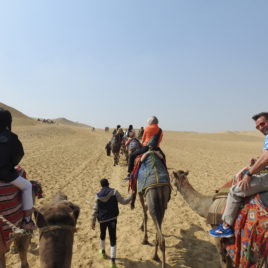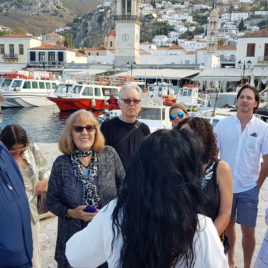
Pilgrimage is an art form. It’s an ancient practice with roots in times where the veil between physical life and the sacred was much thinner.
Since 2003, Sacred Earth Journeys has worked tirelessly to show the world that it’s in dire need of the reinstallation of pilgrimage as a common reason to travel.
Since then, we’ve worked with various teachers, healers, medicine people, and elders from the world’s many sacred traditions.
From the Maya in the Yucatan all the way to Tibetan Buddhism in Nepal, we’ve woven powerful, educational, and healing journeys throughout various landscapes, bringing people together from all walks of life.
A Pilgrimage Revival
According to best-selling author, independent scholar, and veteran travel leader, Phil Cousineau, pilgrimage is a travel experience much unlike those we may be used to. Here’s what he says in his bestselling book The Art of Pilgrimage:
“‘The point of the pilgrimage,’ as a Buddhist priest told the traveling author Oliver Statler on his journey around the Japanese island of Shikoku, ‘is to improve yourself by enduring and overcoming difficulties.’ In other words, if the journey you have chosen is indeed a pilgrimage, a soulful journey, it will be rigorous. Ancient wisdom suggests if you aren’t trembling as you approach the sacred, it isn’t the real thing. The sacred, in its various guises as holy ground, art, or knowledge, evokes emotion and commotion.”
A revival of this type of travel, this pilgrimage, is happening, and it’s reaching the mainstream.

For example, just this past July, National Geographic published an article claiming how “Pilgrimages could be the next post-COVID travel trend”. Their punchline explains how people are turning to traditional pilgrimage routes to reconnect to the world while finding more peace in their lives.
Examples of traditional pilgrimage routes include walks such as the Inca trail through Peru’s Sacred Valley of the Inca and the routes through India and Nepal to visit the sites where the historical Siddhartha Gautama was born, found enlightenment, gave his first teaching, and died.
As Kerry Walker, the author of the article, explains, “For many people, pilgrimage is about making an ‘investment,’ not necessarily in the physical or monetary sense, but rather being willing to open up to change and any consequences that entails. COVID-19 has presented challenges and restrictions the likes of which few people will have faced before. As a result, many will be seeking journeys that might offer change and therapeutic rewards.”
She and her interviewees explain that only a small percentage of modern-day pilgrims’ intentions are religious. The rest are seeking secular inspiration, insight, and these “therapeutic rewards” Walker writes of.
Walker also reports a special emphasis on pilgrimage as a “natural remedy,” that is, choosing an adventure at least partly to connect with the natural world.
In the article, trip leader Iain Tweedale reports how walking through nature has a profound effect on the mind. After days of walking, the mind finally calms, senses sharpen, and the “outer journey” becomes an inner journey to the heart.
Pilgrimage Defined
Walker sites the British Pilgrimage Trust, which defines pilgrimage as:
“(n.): A journey with purpose on foot to holy/wholesome/special places.”
They continue by letting us in on some insight and advice concerning pilgrimage:
“People have made pilgrimage across countless geographies, cultures and eras.
To turn a walk into a pilgrimage, at the beginning set your private ‘intention’ – dedicate your journey to something that you want help with, or for which you want to give thanks.
Pilgrimage is for everyone, promoting holistic wellbeing via pilgrim practices and connecting you with yourself, others, nature and everything beyond.”
Walker mentions the British Pilgrimage Trust by mention of their survey observing that a mere 13% of people partake in pilgrimage for religious purposes.
There seems to be a modern need for pilgrimage that goes beyond the religious. It is a yearning to connect with something larger than life, to feel interconnected with the webs of deeper meaning that are always surrounding us.
As Guy Hayward, cofounder of the Trust, mentions—“holy” is a word that actually means “bringing health.” It comes from the Old English halig (Old English is practically unrecognizable to modern English as we know it).
People are really trying to find healthy ways of existing in the world, whether that be through religious observance or not.
Journey with Sacred Earth Journeys

Our pilgrimages throughout the world’s sacred places are extensive and transformational. We work with traditional medicine people, bestselling authors, spiritual teachers, scientists, and researchers to create rare and unique tours.
For example, a popular journey we’re excited for in 2022 is La Dolce Vita: The Sweet Life of Mythic Italy with Phil Cousineau. Phil worked with us to create “A mythic adventure to the land of gods and goddesses, divine art, the pleasures of everyday life, and breathtaking scenery.”
This journey with Phil is a prime example of pilgrimage for the sake of personal growth and experience (rather than religious intentions); the theme of the journey is la dolce vita—”the sweet life.”
In Italy, we explore the myths, art, literature, fashion, and crafts that uphold life in arguably the most artistic culture in the world.
In a recent interview with Phil, he touches a bit on the journey as well as other themes to do with pilgrimage, his books, and his many trips around the world. He’s truly a knowledgeable journey leader and always a pleasure to travel with.
In 2022, we’re also excited to travel with Dr. Miles Neale on our Finding Buddha with Dr. Miles Neale and Special Guest Geshe Tenzin Zopa. This journey with Miles is more akin to a pilgrimage in its traditional sense; we’ll be traveling through Nepal and India “to discover the milestones of Buddha’s epic biography.”
The journey with Miles, a Buddhist psychotherapist, will bring us to sites such as Sarnath where the historical Buddha gave his first teaching post-enlightenment.
Journeys such as these with Miles Neale and Phil Cousineau are the foundations of Sacred Earth Journeys’ mission to provide trips both educational and transformational to the world’s most beautiful cultures and traditions. We take pride, as National Geographic put it, in being part of the reason why “pilgrimages could be the next post-COVID travel trend.”
~Jacob Lopez, staff writer

